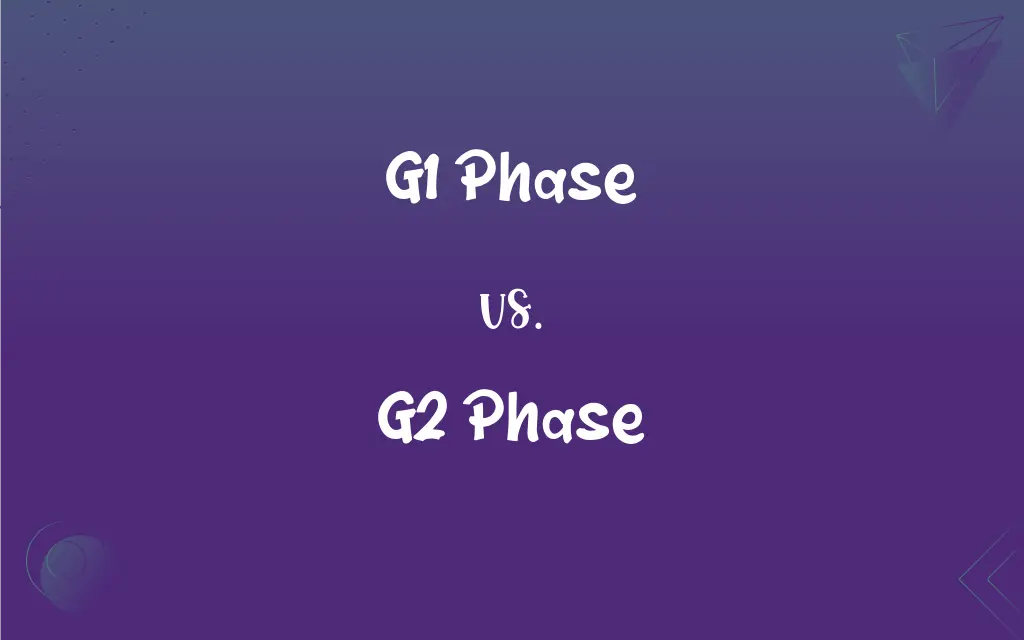G1 Phase vs. G2 Phase: What's the Difference?
Edited by Janet White || By Harlon Moss || Updated on October 4, 2023
G1 Phase is the first growth period in the cell cycle where cells increase in size, while G2 Phase is the second growth period where cells prepare for division.

Key Differences
In the G1 Phase, cells undergo significant growth and synthesize proteins. This is the period following mitosis but preceding DNA synthesis. The G1 Phase is fundamentally about cell growth and the preparation for the next phase: DNA replication. The cell ensures all necessary proteins and organelles are produced during this phase. In contrast, the G2 Phase comes after DNA replication.
The G2 Phase follows the DNA synthesis or S phase. During the G2 Phase, the cell prepares for the process of mitosis or meiosis. It ensures that all the DNA has been replicated correctly and any damage to the DNA repaired. The G1 Phase, on the other hand, sets the groundwork for DNA replication by ensuring the cell has all it needs to support the process.
In terms of duration, the G1 Phase can vary greatly, while the G2 Phase is typically shorter and more consistent in its length. The G1 Phase can even enter a resting stage called G0 if the cell decides not to divide. In contrast, once the G2 Phase is initiated, the cell is committed to undergoing cell division.
Both the G1 Phase and the G2 Phase are critical intervals in the cell cycle, ensuring the cell is ready for DNA replication and subsequent division. While G1 Phase focuses on cell growth and readiness for DNA synthesis, the G2 Phase is centered on the accuracy of DNA replication and preparation for mitosis or meiosis.
Comparison Chart
Focus
Preparation for DNA synthesis.
Preparation for cell division.
ADVERTISEMENT
Follows
Mitosis
DNA synthesis or S phase.
Duration
Can vary greatly; may enter a resting state (G0).
Typically shorter and more consistent.
Critical Processes
Cell growth, protein synthesis, and preparation for DNA replication.
Ensures DNA has been replicated correctly; DNA damage repair.
Commitment
Can choose not to divide and enter G0.
Committed to undergoing cell division once initiated.
G1 Phase and G2 Phase Definitions
G1 Phase
G1 Phase is the cell cycle's initial growth period following mitosis.
After completing mitosis, the cell enters the G1 Phase to grow and prepare for DNA replication.
ADVERTISEMENT
G2 Phase
G2 Phase is a shorter, more consistent phase compared to the G1 Phase.
Whereas the G1 Phase duration can vary, the G2 Phase is typically more fixed in its timing.
G1 Phase
G1 Phase is where cells produce necessary proteins and organelles for the subsequent phases.
The synthesis of essential proteins happens predominantly in the G1 Phase.
G2 Phase
G2 Phase commits the cell to the process of division, leading to mitosis or meiosis.
Once in the G2 Phase, the cell is on a set path to divide, be it through mitosis or meiosis.
G1 Phase
G1 Phase can lead to a resting state called G0 if the cell decides not to proceed with division.
If conditions aren't favorable, cells in the G1 Phase might enter the G0 phase and not divide.
G2 Phase
G2 Phase is crucial for DNA damage repair and verification before cell division.
If there's any DNA damage, the G2 Phase ensures it's rectified before mitosis begins.
G1 Phase
G1 Phase sets the foundation for the S phase by ensuring the cell's readiness for DNA replication.
Before entering the S phase, cells undergo the G1 Phase to ensure they are equipped for DNA synthesis.
G2 Phase
G2 Phase is the second growth period in the cell cycle, preparing cells for division.
After DNA replication, cells enter the G2 Phase to get ready for mitosis.
G1 Phase
G1 Phase emphasizes cell enlargement and preparation for DNA synthesis.
Before replicating its DNA, the cell focuses on growth during the G1 Phase.
G2 Phase
G2 Phase ensures that DNA has been correctly replicated.
Any DNA anomalies are addressed during the G2 Phase before cell division.
FAQs
What is the primary focus of the G1 Phase?
The G1 Phase primarily focuses on cell growth and preparation for DNA synthesis.
When does the G2 Phase occur in the cell cycle?
The G2 Phase occurs after the DNA synthesis or S phase.
What does the G2 Phase ensure regarding DNA?
The G2 Phase ensures that DNA has been correctly replicated and any damage has been repaired.
Can the G1 Phase lead to a resting state?
Yes, the G1 Phase can lead to a resting state called G0 if the cell decides not to divide.
Is the G2 Phase longer than the G1 Phase?
Typically, the G2 Phase is shorter and more consistent compared to the varied duration of the G1 Phase.
Are the durations of the G1 and G2 Phases fixed?
The G1 Phase can vary in duration, while the G2 Phase is typically shorter and more consistent.
Which phase ensures cells have all they need for DNA replication?
The G1 Phase ensures cells are equipped with everything they need for the subsequent DNA replication.
In which phase does the cell produce necessary proteins and organelles for subsequent phases?
The G1 Phase is where the cell produces necessary proteins and organelles for the subsequent phases.
Does the G2 Phase ever lead to a resting state like G0?
No, once the G2 Phase is initiated, the cell is committed to undergoing cell division and doesn't enter a resting state like G0.
Can a cell revert from the G2 Phase back to the G1 Phase?
No, once the cell is in the G2 Phase, it is committed to undergoing cell division.
Why might a cell enter the G0 phase from the G1 Phase?
A cell might enter the G0 phase if conditions aren't favorable for division or if it's a cell type that doesn't divide frequently.
Which phase emphasizes cell enlargement?
The G1 Phase emphasizes cell enlargement and preparation for DNA synthesis.
What happens if DNA is damaged during the G2 Phase?
The G2 Phase has mechanisms to repair DNA damage before the cell proceeds to division.
Which phase is directly after mitosis?
The G1 Phase directly follows mitosis in the cell cycle.
Is the G1 Phase about cell division?
No, the G1 Phase is about cell growth and preparation for DNA replication, not division.
How does the G2 Phase handle DNA anomalies?
The G2 Phase addresses any DNA anomalies by ensuring repair and verification before cell division.
What follows the G1 Phase in the cell cycle?
The G1 Phase is followed by the S phase, where DNA synthesis or replication occurs.
Are both the G1 and G2 Phases crucial for cell division?
Yes, both phases ensure the cell is prepared for DNA replication and subsequent cell division.
What ensures the cell's readiness for mitosis or meiosis?
The G2 Phase ensures the cell's readiness for mitosis or meiosis by verifying DNA replication accuracy and making necessary preparations.
Does the G2 Phase prepare the cell for DNA replication?
No, the G1 Phase prepares the cell for DNA replication. The G2 Phase prepares the cell for division.
About Author
Written by
Harlon MossHarlon is a seasoned quality moderator and accomplished content writer for Difference Wiki. An alumnus of the prestigious University of California, he earned his degree in Computer Science. Leveraging his academic background, Harlon brings a meticulous and informed perspective to his work, ensuring content accuracy and excellence.
Edited by
Janet WhiteJanet White has been an esteemed writer and blogger for Difference Wiki. Holding a Master's degree in Science and Medical Journalism from the prestigious Boston University, she has consistently demonstrated her expertise and passion for her field. When she's not immersed in her work, Janet relishes her time exercising, delving into a good book, and cherishing moments with friends and family.































































